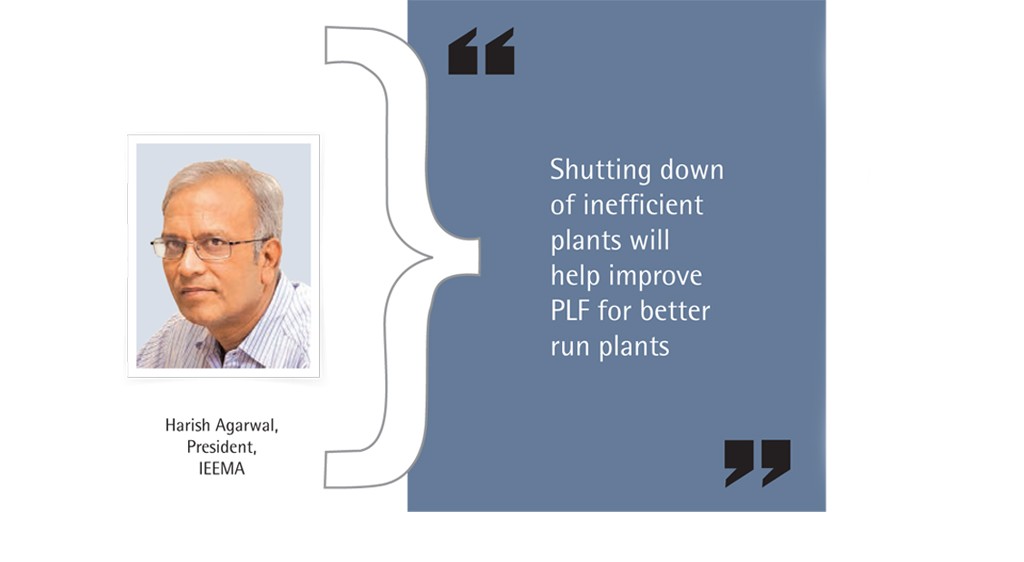Grid, substitute for generation
By EPR Magazine Editorial February 7, 2019 5:33 pm IST
By EPR Magazine Editorial February 7, 2019 5:33 pm IST

Shutting down of inefficient plants will help improve PLF for better run plants
Harish Agarwal, President, IEEMA
India is becoming a single grid where the facility of transmission is being used by both those who are generating and those consuming, says Harish Agarwal, President, IEEMA, in an exclusive interview with EPR. He stresses upon the current scenario of the transmission and distribution sector, and shares his opinions on improving the grid and the overall process of transmission.
How would you define the current scenario of the extensive network of transmission lines in India?
The order level, which the power grid or the transmission sector was maintaining is not the same right now. It has been reported that plans are being made to float new tenders in the transmission sector due to the need for more renewable integration. Now, we also have one nation-one grid with 175 GW power delivery being handled. So, this is a very good foundation for integrating and balancing the intermittency of renewables. Ambitious renewable targets would definitely need much bigger grid to achieve the required load balancing. There is also currently significant business coming from transmission at intra-state level and sub-transmission level. The market character is also changing gradually; there are more contracts coming in from private players and there’s more business coming out of open competitive bidding. Also, use of HTLS conductor for reconductoring and a plethora of line compacting solutions will be a new area of business opening space for innovators.
Any policy that can be considered as a game changer for the Indian transmission sector?
I can’t say of any particular policy, but the grid is now thought to be more and more reliable as time passes. Settlements are taking place for every 15 minutes, which they want to reduce to every 5 minutes. So, that will definitely increase the demand for the transmission infrastructure because the infrastructure is now required to be more and more reliable and as such more redundancy would be required to be there in the system. Some transcos would require to get upgraded and grid needs to be more resilient. Moving forward grid would be seen as the substitute for generation where you have the nationally determined price and any inefficient generation whose cost of generation is substantially higher than the price at which the power is traded, will cause those plants to be automatically shut down and the power supplied by an efficient plant to the national grid would be purchased by the users. Shutting down of inefficient plants will help improve PLF for better run plants.
Do you think there is a need to replace the ageing distribution of infrastructure in India?
That is already being done. If you see that IPDS, there are attempts to make network healthier. There is need for power quality improvement. Once you have AMI meter for better sensing and a data analytic device built into the system, you could really locate where things are actually going wrong and will then be able to facilitate corrective measures. In fact, UDAY visualises feeder level and DT level metering, which is still to take place. Some of the better DISCOMs in private as well as public sector have definitely been able to do a lot of things in this area. Particularly, if you look at NDPL and CESC, they do have very healthy and world class network. The moment there is universal access of power, people would demand better quality and look out for more reliable power. A lot has to be done to have a proper alignment.
How about automating the T&D sector?
There is no alternative to automation in power distribution. Automation is required for proper accounting, necessary diagnostic analysis, and to have the next level of improvement. But, as of now, automation has, so far, penetrated only to a few of the enlightened DISCOMs and 72 towns covered by RADRP as a result of which SCADA systems and RTUs were commissioned. MOP is trying to bring almost 25 million consumers under the scope of AMI and prepaid meters. For power grid most of the substations are now unmanned. At transmission level, the system is quite automated. The distribution automation is gradually coming in, but it will take more time. But, utilities aiming for very high uptime and very low T&D losses have gone for substantial automation.
To what extent the ROW issue or the environmental clearance issue are affecting the power utilities?
Right now, the ROW issue or the environmental clearance issue is one of the major concern. It is one of the bottleneck in the growth of transmission sector. No one can avoid environmental issues or put it on the backburner. They are as important as increasing the transmission penetration in India. But the thing is the delay in dealing with the environmental issue won’t help anybody’s cause. We need to devise the method where we get result much faster than what they are today and subsequently once the decision is taken on environmental clearances any alternative routes if required will be used.
We use cookies to personalize your experience. By continuing to visit this website you agree to our Terms & Conditions, Privacy Policy and Cookie Policy.